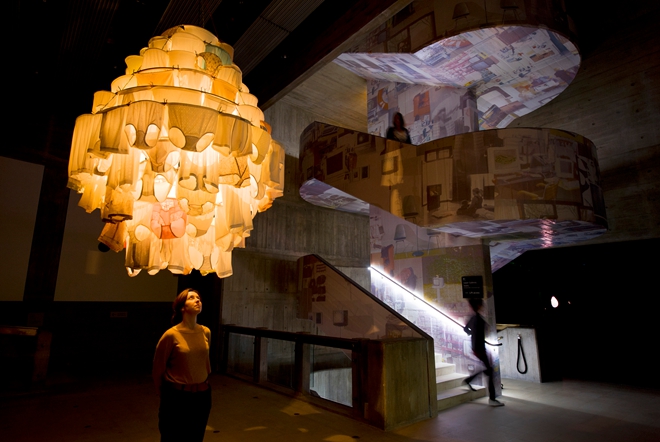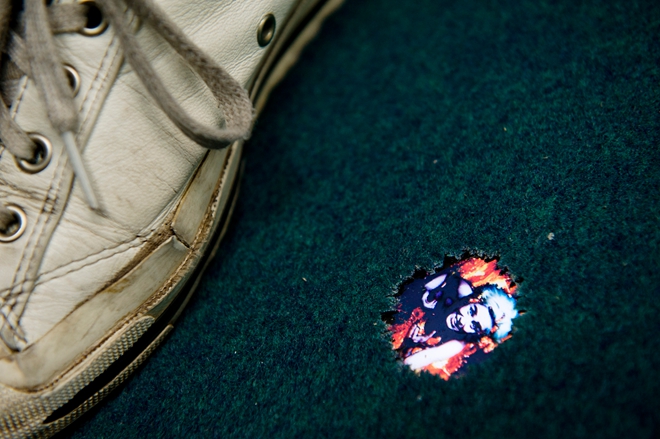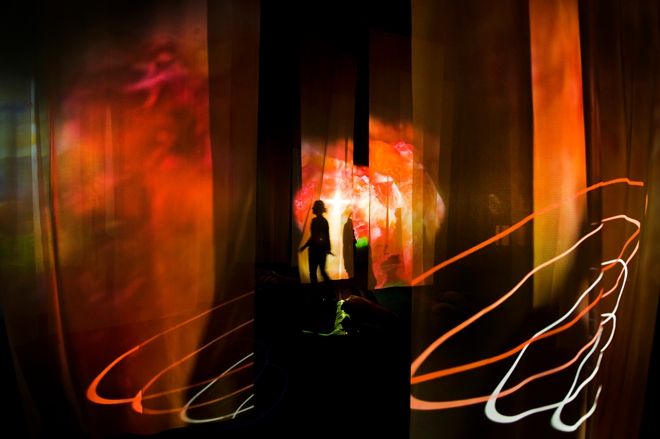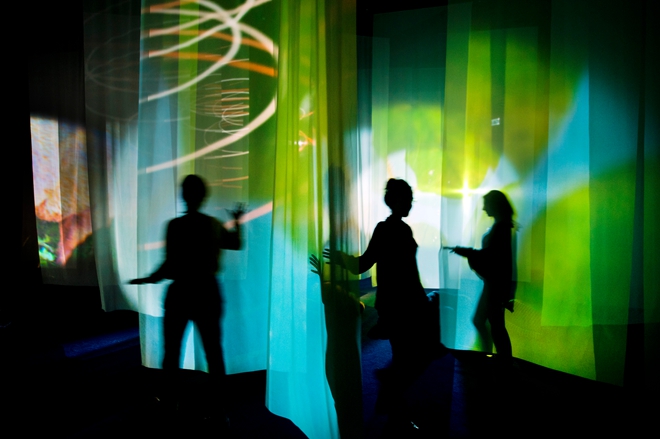How was it for you? “Moving Image in China,’” I mean. Did you enjoy it?
Perhaps “enjoy” is not the right word”… We were interested — but not necessarily amused.
Minsheng’s survey was a momentous, systematic show of video art, much of it both historic and remarkable. Check. Chinese artists have done much to involve themselves with this medium. Check. Beginning with Zhang Peili’s “30×30” (1988), the show orchestrated a chronological tour through over 50 works by over 30 artists. Check. Some aspects were moot: the exhibition’s inclusiveness, for example, because according to the Book of Minsheng, “China,” means largely the mainland, and on the flip side, one needn’t quibble over the distinction between video artists and artists who happen to have made a video work. Not to mention – as Phil Tinari recently let slip — “‘mini-scandals’ over things like whose work was projected versus played on a screen…”(1)

展览场景: Pipilotti Rist, “眼部按摩”, Hayward 画廊。前景: “Massachusetts Chandelier,” 2010. 楼梯:”I Never Taught in Buffalo,” 墙纸, 2003/2011. [摄影: Linda Nylind]
“Eyeball Massage” surveyed Rist’s oeuvre to date. The first room juxtaposed a luminescent “chandelier” composed of frumpy white knickers (perhaps a play on illuminating the ordinary) and a miniature, box-like suburban home laid out on the floor complete with reddish internal lights, a little mower on the lawn, etc. The back wall was a blanched collage of household items and packaging — egg boxes, polystyrene fillers, t-shirts. An ephemeral layer alighted via mobile projections swimming over the walls and installations, animating the objects’ surfaces. There were fixed projections here, too — a small one onto the wall of the model house and another in which the artist remarks on relationships from the passenger seat of a car — but their narratives dissolve against the psychedelic environment. As befitting the exhibition’s title, images and coloured light caressed the fringe of vision in the corners of the eyes.
The setting Rist creates is often immersive, less accessible to those who refuse to give way to her particular brand of optical lube than to non-initiates of video art practice (no bar to enjoyment here – not so chez Minsheng). One room was rendered like a tank for floating imagery and sound. Thin white drapes (Rist’s fabled “image-carriers”) caught projections of glistening beards, big masticating lips and goats in pastures. Rist’s camera-eye zooms unflinchingly towards and around its subjects, casting the viewer into a hyper-reality wherein inward sensations seem to meld with sensory information. Visitors were encouraged to recline on the floor, padded by surreal stuffed trousers and jumpers left lying about, and bask in Rist’s dilated, drooling world. For her, the way to viewers’ hearts is through their eyes, ears and stomachs; her project is to galvanize our guts with sound and images. There’s even a shot of her anus at one point, which just goes to show there are no holes barred.
展览场景。 Pipilotti Rist: “眼部按摩”, Hayward 画廊。 “Selfless In the Bath of Lava (《忘我地熔岩浴》)(1994). [摄影: Linda Nylind]
“Eyeball Massage” wholly reflected Rist’s ambition to intervene in customary “viewing rituals.” Where this retrospective charted her personal mission to change our experience of moving images, challenging the bilateral convention of cinema to place pictures and light above, below, onto and around her audience (she’d project onto our insides if she could), at Minsheng, the medium was definitely not the message. Visitors progressed through a dark display organised around time periods that inherently drew attention to narrative (yawn – are we there yet?), rather than to the experiential properties or potentials of video. Reviewing the show for LEAP magazine, Tang Lingjie called it “conservative”(3), whereas theGuardian’s critic, a delirious Adrian Searle, deemed Rist’s exhibition “an environment”(4). A few flashes of experiment with the mechanisms of seeing did appear within some of the early works at Minsheng: “Washroom” was projected onto the floor, “Sight Adjuster-3” (1996) by Shaohong Chen offered each eye its own screen at the end of a concertinaed extension from two TVs, and Goang-Ming Yuan’s 1995 video showed footage from inside a bird cage. But as the years — and the exhibition — unfolded, this impulse evaporated entirely. “Eyeball Massage,” was a product both of the artist’s intent to probe perception in her own way and the gallery’s willingness to animate its space (much as one critic might have criticised this as a staging of “art for the crowd-hungry Kunsthalle”(5), to which, in this instance, so what?). “Moving Image in China,” on the other hand, was content with sedate linearity.
So, a blithe circus of video from Pipilotti Rist in London, and a funless survey of Chinese art in this medium by Minsheng Museum; one show of moving image work sheds useful light on another (and vice versa, if you so choose). True, these are overarm observations, but responses to exhibitions — especially those in the same medium — need not always be insulated by their proximate contexts. It spoils all the fun.
![展览场景: Pipilotti Rist: "眼部按摩", Hayward 画廊。 "Administrating Eternity" (2011). [摄影: Linda Nylind]](http://www.randian-online.com/wp-content/uploads/2012/03/pr11-245x245.jpg)


